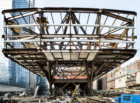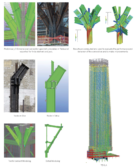Visitors could be forgiven for mistaking One Manhattan West, a 995-foot-tall tower in Midtown, for a typical office building. Its simple geometric form and the polished appearance of its glass facade give little indication of the unconventional engineering techniques—above and below ground—required to build it. The 67-story, 2.1-million-square-foot office tower, located on the corner of Ninth Avenue and 33rd Street, is the first new office tower to open as part of Brookfield Properties’ Manhattan West, an eight-acre district being developed on Manhattan’s West Side.
The glass and steel structure faces the new Moynihan Train Hall and was built above active railroad tracks, which, for the architects and engineers, meant minimal buildable land to work with. The tower is conceived as one of two skyscrapers on Ninth Avenue which form a gateway to the entire development, including two acres of outdoor public space. Thanks to an innovative integration of the design and fabrication process, One Manhattan West was built on an ambitious construction timeline on this challenging site.

Discussions around building over the West Side rail yard date back to the 1950s. Finally, after a 2005 rezoning of the area was approved by the City Council, a new plan to utilize the site’s rail and air rights could be realized. Brookfield Properties then secured the development rights for a 5-million-square-foot development between Ninth and Tenth avenues, built entirely above the active infrastructure.
The rail yard leaves about 130 feet between the northernmost track and 33rd street. A viable office tower, however, requires a minimum width of about 150 feet in order to have appropriate lease spans (the distance between a building’s window line and its core wall exterior side). As a result, the available area for One Manhattan West’s foundation is considerably smaller than its total footprint. While the building’s central core could be anchored on bedrock, none of the perimeter columns on the south side could touch the ground. In order to balance the structure, all perimeter columns on the tower’s south, north, and east sides slope into the core above the lobby level.
The design turns an engineering challenge into a dramatic centerpiece: a travertine-clad pillar at the center of the lobby follows the sloping form of the columns, echoing the inward column transition. Its structural glass fin perimeter wall creates a transparent enclosure around the lobby, establishing a visual harmony between the tower and surrounding plaza. The structural glass wall coupled with the architectural expression of the sloping tower, emphasizes the openness of the lobby, making One Manhattan West’s structural solution its focal point.


An unconventional design required an unconventional workflow. The pressures of Manhattan’s real estate market called for an accelerated construction schedule. And the complex geometry at the base of the tower would make the typical process of submitting 2D drawings to steel fabricators for 2D shop drawings insufficient. SOM engineers decided to try something new, detailing the complex steel in a 3D model using Tekla—a building information modeling software—in order to deliver the most accurate design information, including the center line geometry of all structural steel members, complete with material property data and testing requirements.
The team simultaneously delivered 3D Tekla steel detailing models with the production of construction documents and during the bidding process. The result: a more efficient design, done in less time, for less money. For steel fabricators and erectors, the model served as a powerful communications tool: clear and rigorous documentation of the complex steel shapes and their connections greatly increased confidence about constructability and costs.


Since working on One Manhattan West, our structural engineers have continued to create advanced 3D steel detailing models, using them during the bidding process to give all parties involved a more accurate project scope. Now, once a project is awarded, fabricators no longer have to regenerate the building’s geometry and connections from 2D drawings, but can limit their modeling work to construction-related modifications. The advantages of the 3D detailing model were manifold. Coupling the cloud-based 3D model with online meetings and the ability to work on and share a single model in real-time allowed for critical modifications and connections to take place in a matter of hours instead of weeks.
This approach to delivering engineering design information for One Manhattan West dramatically shortened the RFI (Request For Information) process and shop drawing review process. As a result, construction was able to start six months earlier than originally anticipated, while the tower’s steel components were connected with ease, despite its geometric complexities. For those who know its story, One Manhattan West gains a special significance on the skyline: a monument to technology and to inventing solutions.
